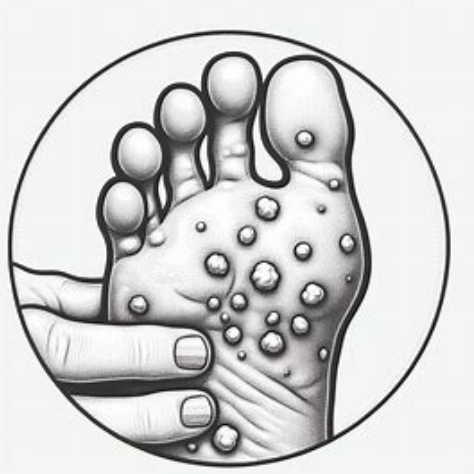As a podiatrist, I often encounter patients presenting with localized thickened skin on their feet, commonly mistaking corns, calluses, and plantar warts for one another. While these conditions may appear similar, they have distinct causes, characteristics, and treatment approaches. A clear understanding of their differences is essential for accurate diagnosis and effective management.
1. Pathogenesis of Corns (Heloma)
Corns develop as a result of chronic pressure and friction, typically over bony prominences such as the dorsal aspects of the toes or the plantar forefoot. The skin thickens in response to repeated mechanical stress, forming a localized, hyperkeratotic lesion with a central, dense core that can exert pressure on underlying soft tissues, leading to pain and discomfort.
There are two primary classifications:
- Hard corns (Heloma durum): Typically found on weight-bearing surfaces, such as the dorsum of the toes or the soles of the feet.
- Soft corns (Heloma molle): Develop between the toes where moisture maintains a softer, macerated texture.
Contributing factors include ill-fitting footwear, structural foot deformities (e.g., hammertoes, bunions), abnormal gait mechanics, and prolonged ambulation.
2. Differentiating Corns from Calluses
Although both corns and calluses result from mechanical stress, their presentations differ:
- Calluses (Tyloma) are diffusely thickened, hyperkeratotic plaques that develop over broad areas subjected to repetitive pressure, most commonly on the plantar aspect of the foot (e.g., metatarsal heads, heels).
- Unlike corns, calluses lack a central core and are generally asymptomatic, unless they become excessively thickened or fissured.
- Callus formation is often observed in individuals with abnormal weight distribution, excessive pronation, or barefoot ambulation.
3. Distinguishing Corns from Plantar Warts
Plantar warts, caused by human papillomavirus (HPV) infection, can clinically mimic corns but have distinct diagnostic features:
- Plantar warts disrupt normal dermatoglyphic patterns (skin lines), whereas corns do not.
- Warts exhibit thrombosed capillaries, appearing as small black punctate dots, which are absent in corns.
- Unlike corns, plantar warts are viral in etiology and not caused by mechanical pressure alone.
- Warts typically elicit pain upon lateral compression (“squeeze test”), whereas corns are painful with direct downward pressure.
- Warts may occur as solitary lesions or in a mosaic pattern, often in high-moisture environments such as swimming pools or locker rooms.
4. Treatment and Management Considerations
- Corns and Calluses: Management focuses on mechanical offloading (proper footwear, orthotic modifications), keratolytic therapy (e.g., urea or salicylic acid), and debridement performed by a podiatric specialist.
- Plantar Warts: Treatments include cryotherapy, salicylic acid applications, laser therapy, or surgical excision, depending on lesion severity and patient response.
For persistent or painful lesions, a comprehensive podiatric evaluation is recommended to ensure proper diagnosis and prevent complications.

